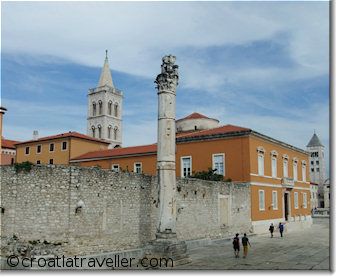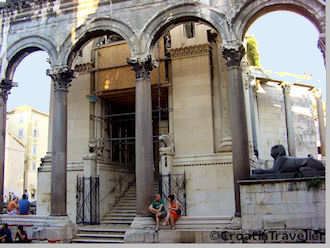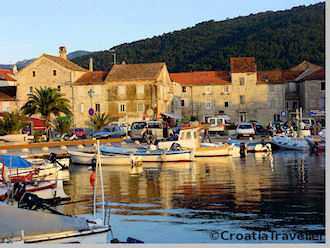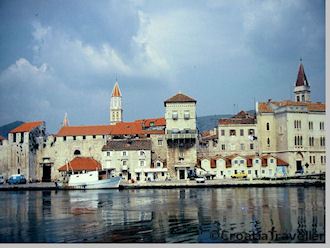Pre-History
Archaeological remains found in the region indicate that the Dalmatian coast was inhabited through the Paleolithic and Mesolithic eras. Early Neolithic remains were found at Smilcic, near Zadar; middle Neolithic remains were found at Danilo near Sibenik; late Neolithic remains were found on Hvar island.
The second millennium BC saw the establishment of the Illyrians which include the Histrians, Liburnians, Dalmats, Daorsions, Ardiyeians, Plereyians and other tribes.
Classical Period
Direct trade links between the ancient Greek world and the Adriatic date back to the 6th century BC when the first Greek settlements were established. At the beginning of the 4th century BC Dyonisius the Elder founded a colony in the old settlement of Issa, now Vis. The goal was to protect his other interests in the Adriatic. Soon afterwards, the inhabitants of Paros established the colony of Pharos, now Stari Grad on Hvar Island. A few centuries later, Issa founded its own trading posts at Tragurion (Trogir), Epetion (near Split) and another near the village of Lumbarda on Korcula Island.
Roman Period
The first Illyrian state was founded in the 3rd century BC and soon created trouble with other Greek colonies on the Adriatic. Rome was expanding its power in the Adriatic and the colonies sought protection from Rome. Illyria soon found itself at war with Rome but managed to hold out for nearly 250 years against Roman rule. The last major uprising by the Illyrians was crushed in 9AD.
The Roman province of Illyricum included the entire Adriatic coast and extended deep into the Croatian interior. The name "Dalmatia" first appeared in the 1st century BC. The name evolved rom the most famous and warlike tribe, the Delmati. By the end of the 1st century BC the former Illyricum was known as Dalmatia.
The capital of Roman Dalmatia was Salona, now Solin, which became a trading center and the hub of Roman roads radiating out to the rest of the province. Other important Roman towns included Iader (Zadar), Narona (Vid), Epidaurum (Cavtat), Senia (Senj), Issa (Vis) and Arba (Rab). 4
The Emperor Diocletian divided Dalmatia into two parts but he abdicated in 305AD and retired to his palace in Split.
When the Roman empire split in 395, Lower Dalmatia (southeast of Dubrovnik in today's Montenegro) became part of the Eastern Roman or Byzantine empire while Upper Dalmatia became part of the Western Roman empire. King Odoacer of Italy took over Dalmatia until the region fell to Theodoric, the kind of the eastern Goths.
From Byzantines to Slavs
In 535, Dalmatia fell under Byzantine rule which launched a period of prosperity until the Avars and the Slavic tribes migrated to the Balkans and began attacking the northern borders of the Byzantine Empire. By the beginning of the 7th century, the Slavs occupied the entire Balkans by chasing the inhabitants out of former strongholds such as Salona and Epidaurum. Although the Slavs and the Avars had their eye on Constantinople, their failure to capture it fractured their alliance. The Slavs continued their push towards either conquering or assimilating the indigenous Roman and Illyrian populations along the coast.
The Franks
Near the end of the 8th and beginning of the 9th centuries, the Franks began making inroads into the region, taking on the Byzantine navy. The peace treaty of 812 gave Charlemagne Dalmatian Croatia except for the towns of Zadar, Trogir, Split, Dubrovnik, Cres, Losinj, Krk and Rab which remained part of Byzantine Dalmatia. Christianized Croats clustered around the Zadar, Nin, Biograd and Split which became the political centers of the Croatian principality.
Croatian Kings
Meanwhile Venice was rising as a maritime power, their progress impeded by the pirates plying the Croatian coast. They were forced to pay for safe passage which strengthened the power of the Croatian kings. King Tomislav took power in 925 and headed a large Croatian military force. Upon his death however, Croatian power weakened, Byzant took back its Dalmatian towns and Venice resumed its attacks on the coast.
In 1058, King Kresimir took power as "King of Dalmatia and Croatia", extending his rule along the coast and far inland. He was succeeded by King Zvonimir but his death set off a factional fight. His widow's brother invited the Hungarian king Ladislav Arpadovic to accept the crown. His successors ruled Croatia until 1301 when the Angevins took over.
Venice
A century of turmoil and rebellion culminated in 1409 when Kind Ladislav of Naples sold Dalmatia to Venice. The original package included Zadar, Novigrad and Pag but Venice quickly acquired Cres, Rab, Hvar, Brac, Korcula, Nin, Skradin, Sibenik, Trogir and Split. The Venetian republic remain in Dalmatia until 1797 when Napoleon Bonaparte ended Venetian rule.
French, English, Austrians
Although Austria was assigned Dalmatia in 1797, in 1805 another peace treaty transferred their lands to the French who occupied Dalmatia beginning in 1806. Their ancient rivals, the English quickly arrived in the region and based themselves on Vis Island, defeating a combined French-Italian fleet to take possession of Hvar, Korcula and the Elaphiti islands. They withdrew in 1816.
The Viennese Congress in 1815, handed all the French possessions in Dalmatia to Austria. Meanwhile the Dalmatian population, along with the rest of Croatia, had become restive and made increasingly insistent demands for autonomy and unification.
The outbreak of WWI intensified these sentiments, particularly when Austria began rounding up the more vocal leaders and charging them with treason. Those who escaped regrouped in Italy with the aim of uniting the south-Slavic lands.
Kingdom of Croats, Serbs and Slovenes to Yugoslavia
The Kingdom of Serbs, Croats & Slovenes came into being with the collapse of the Austro-Hungarian empire after WWI but substantial portions of Dalmatia were left under Italian control. The Treaty of Rapallo in 1920 left Italy with Istria, Cres, Losinj, Rijeka, Zadar, Lastovo and Palagruza.
Under the leadership of Marshall Tito, Dalmatia participated in resistance to Germany and Italy during WWII. Dalmatia gave about 110,000 fighters and resisters to the war effort and some 71,000 Dalmatians fought with various units throughout Yugoslavia. After the surrender of Italy, partisan units disarmed Italian troops and freed Dalmatia and its islands. Fearing the possibility of an Allied landing from nearby Italy, large German forces occupied the coastal area and the islands with the exception of Vis Island which Tito and his partisans turned into a fortress. During the course of 1944, Tito headquartered there, directing military operations throughout the country. Battles for the final liberation of Dalmatia began in the autumn of 1944 and by the end of that year the enemy had been driven out. Yugoslavia was born.
Join the Croatia Traveller Group
Recommended Experiences
©CroatiaTraveller 2005-2024 All rights reserved

 Croatian History
Croatian History
 Istrian History
Istrian History History
of Zagreb
History
of Zagreb




